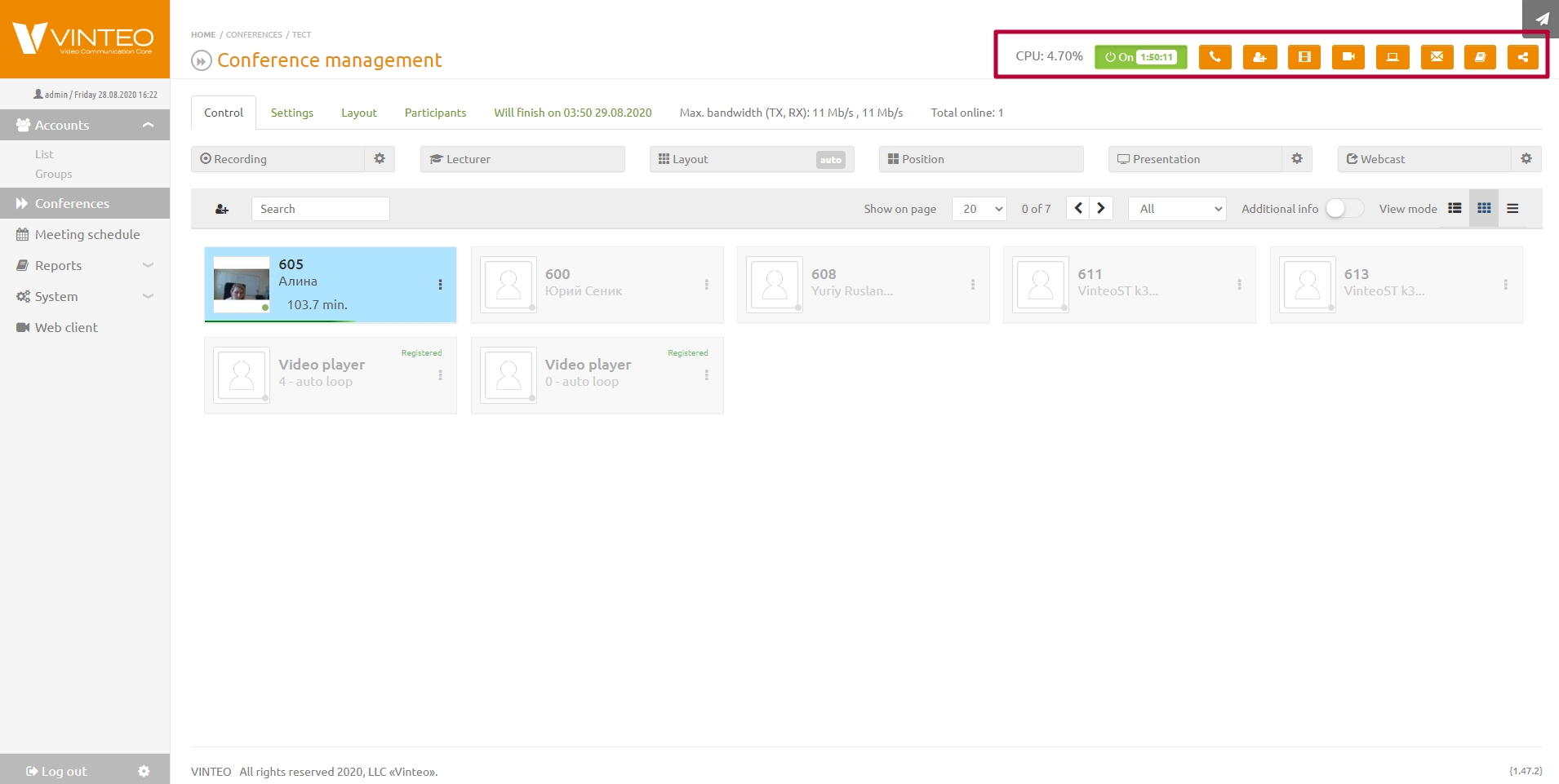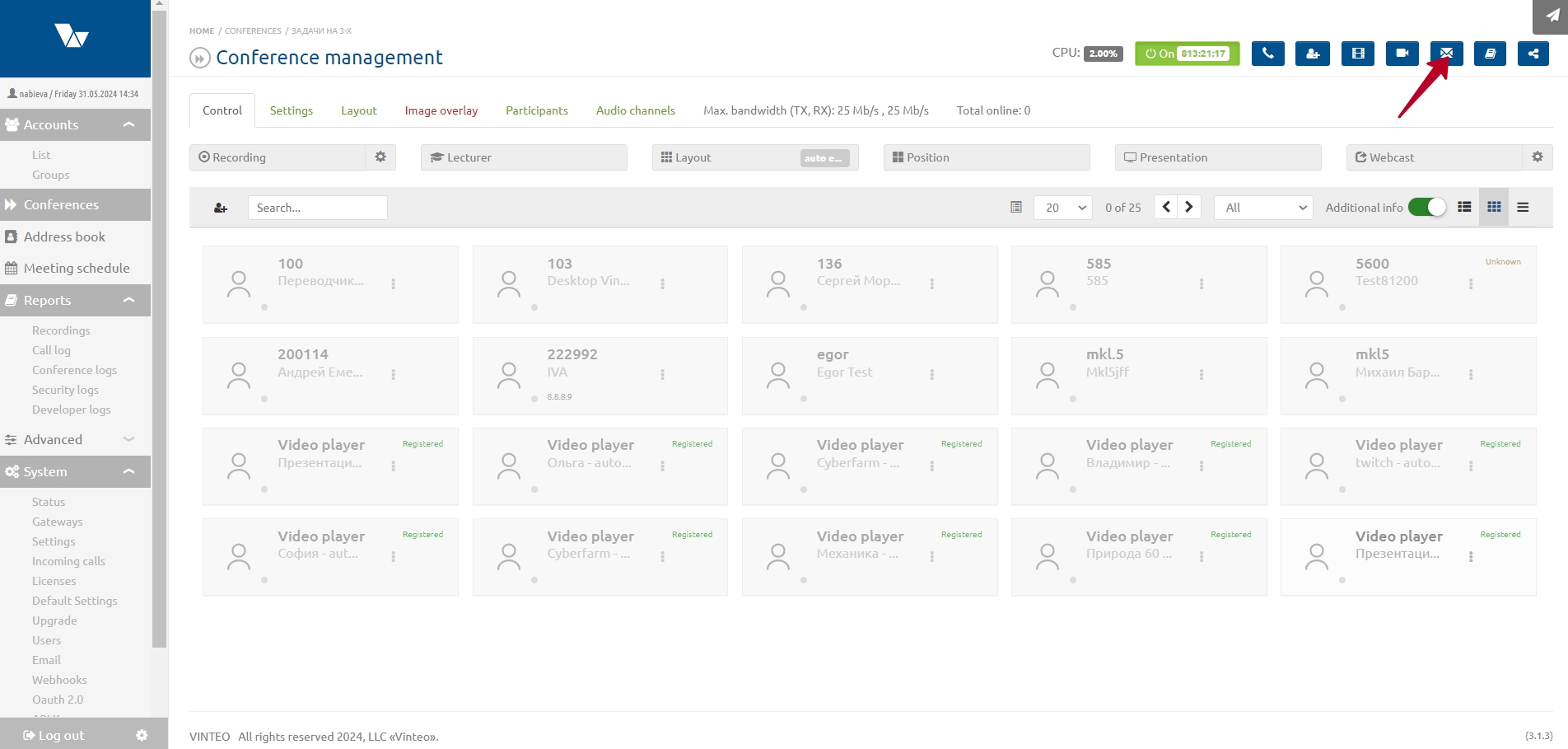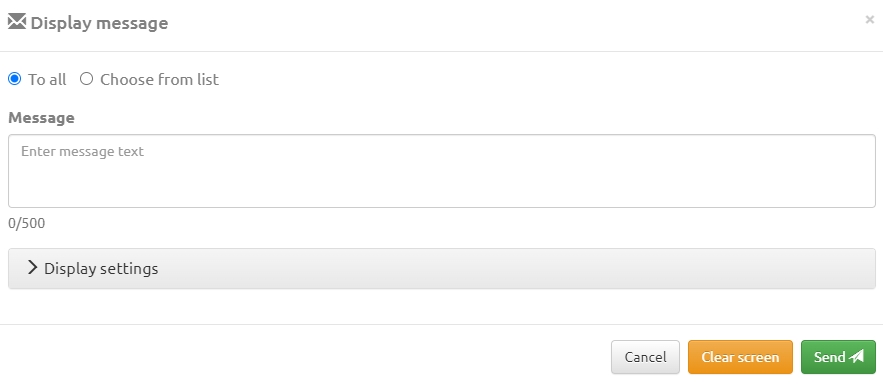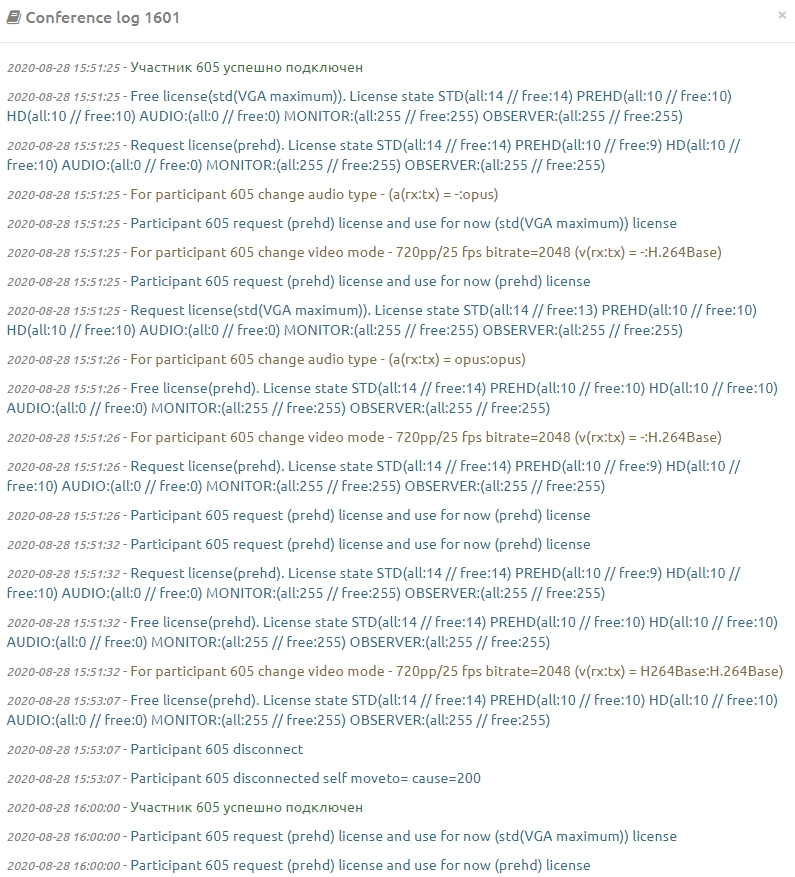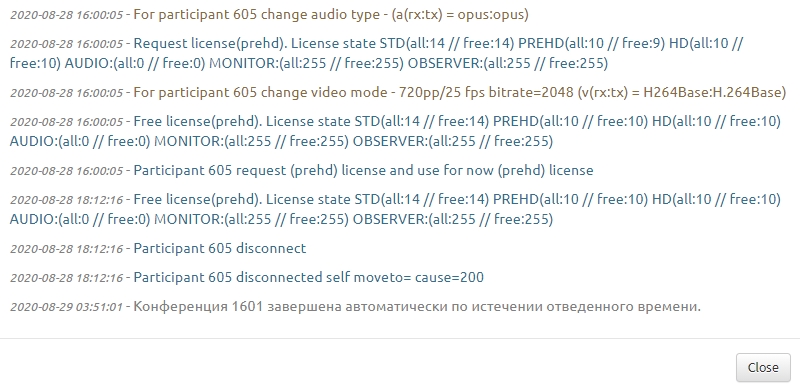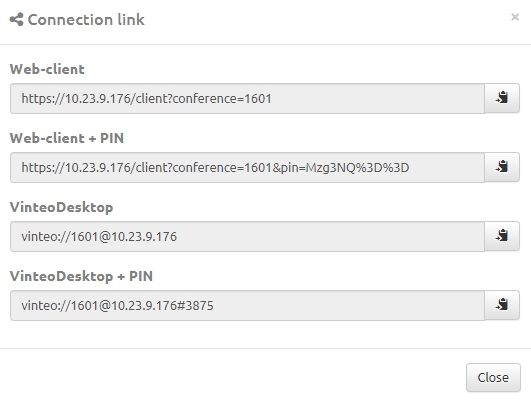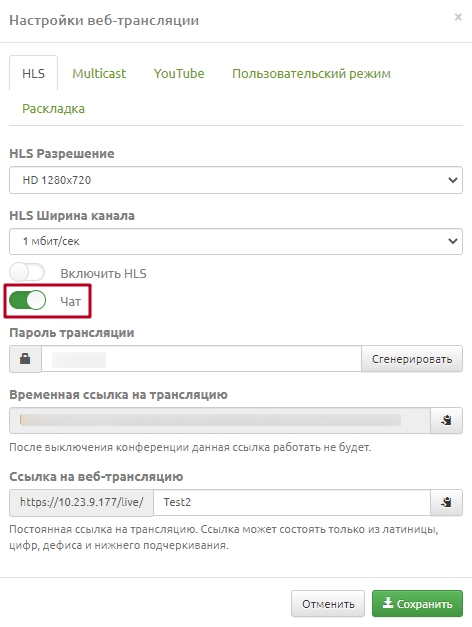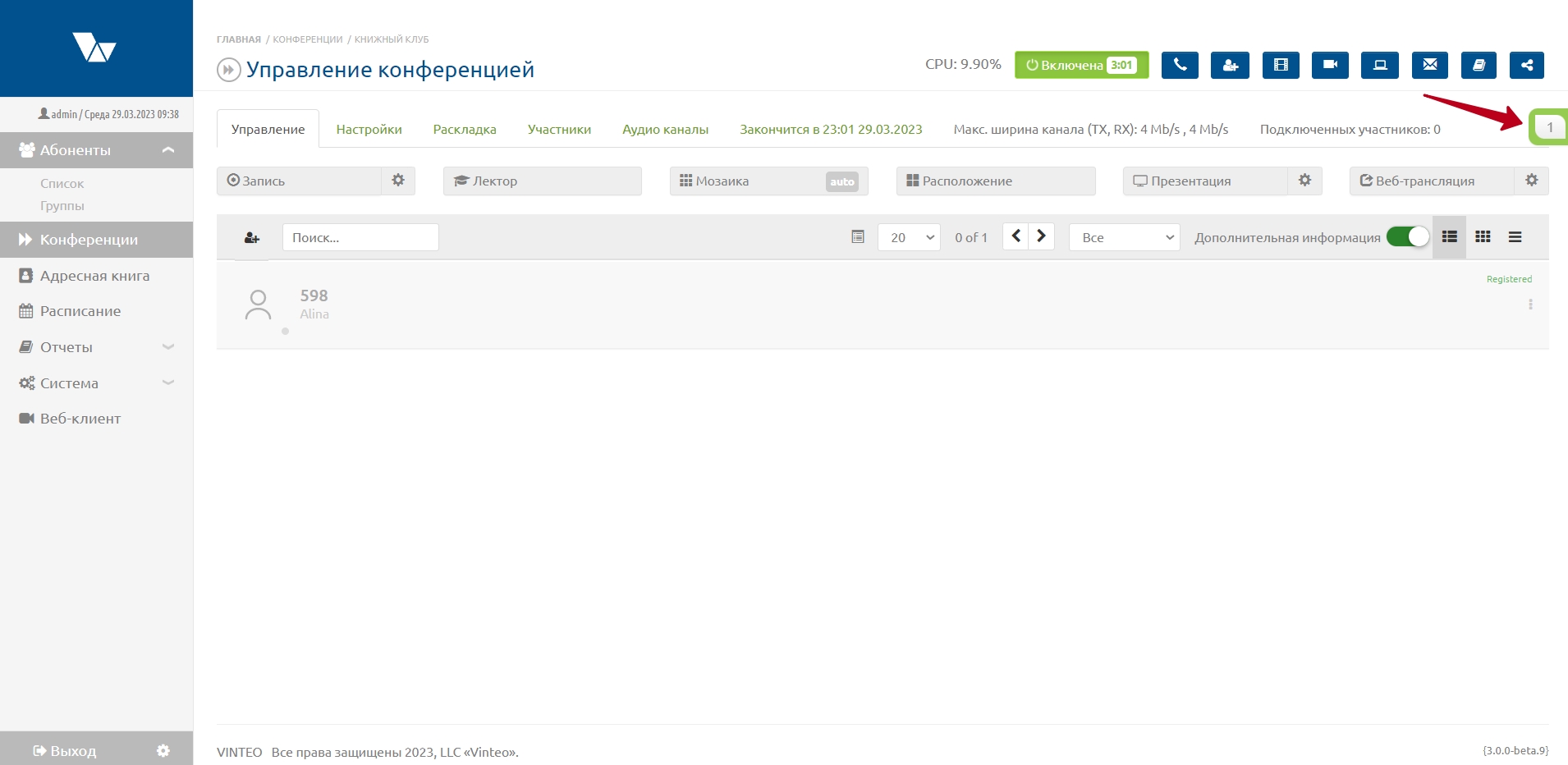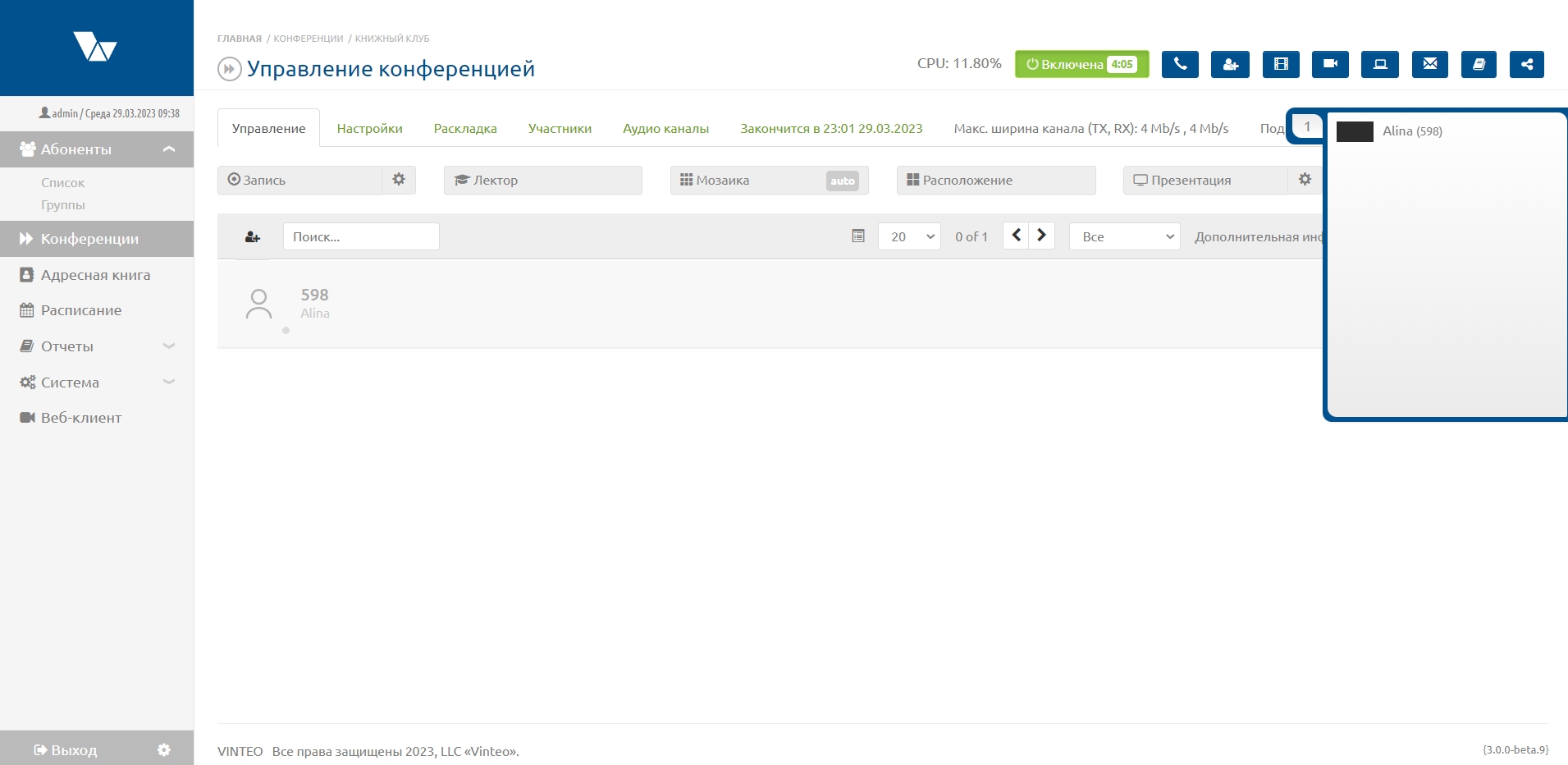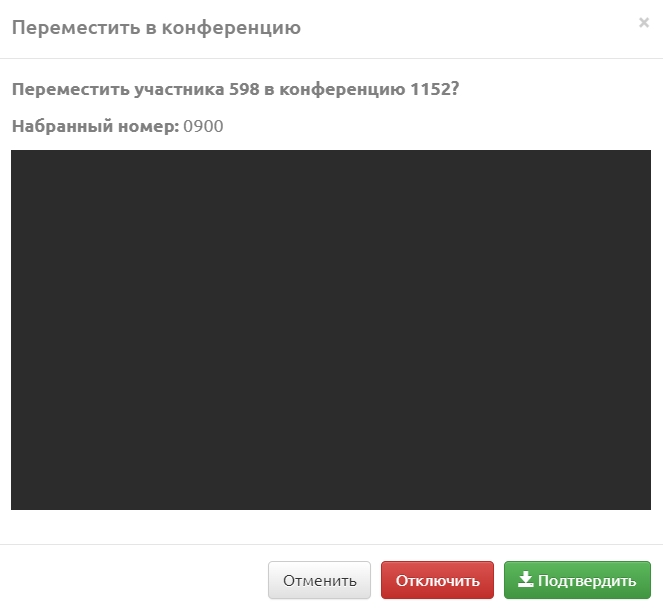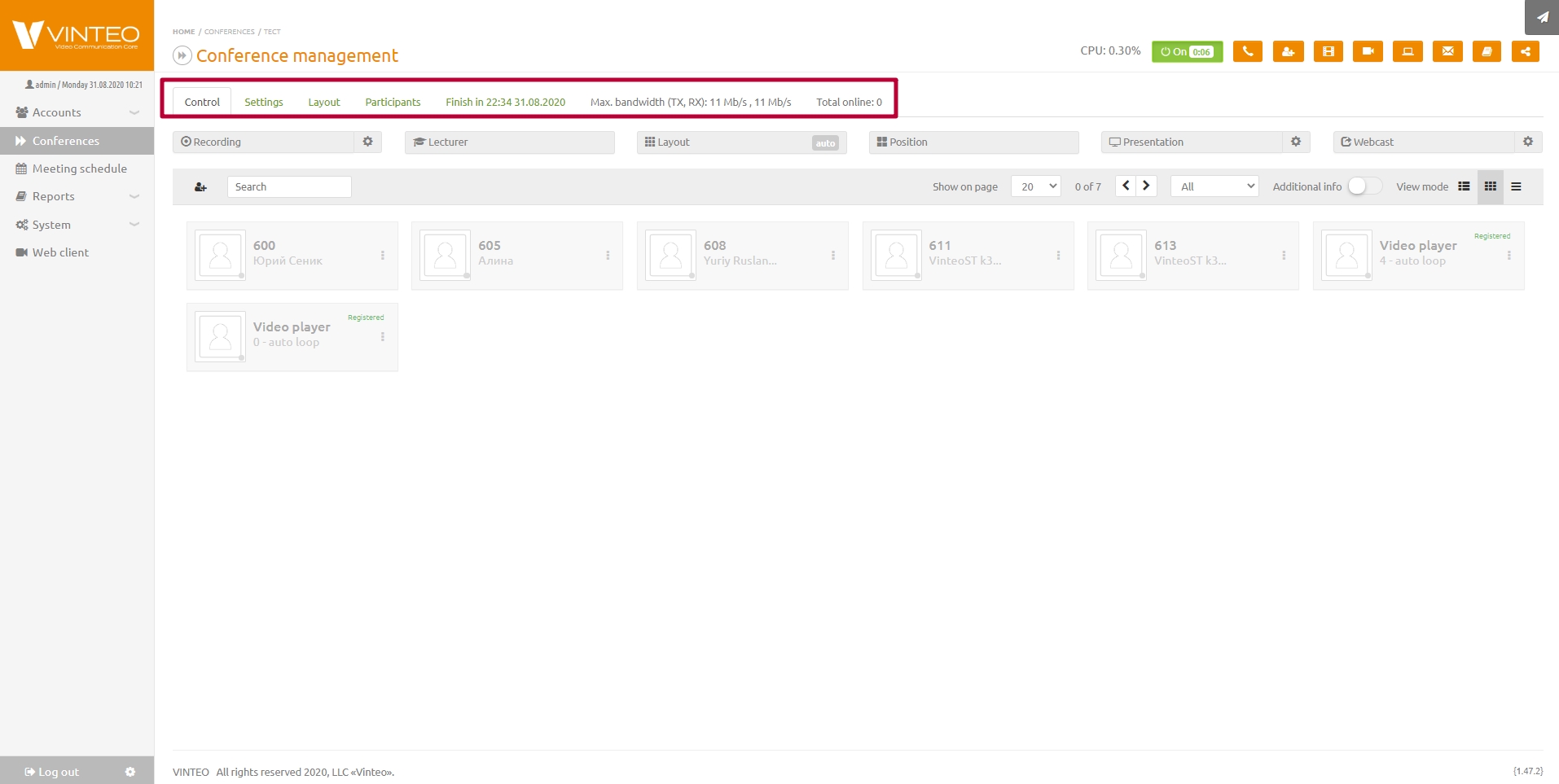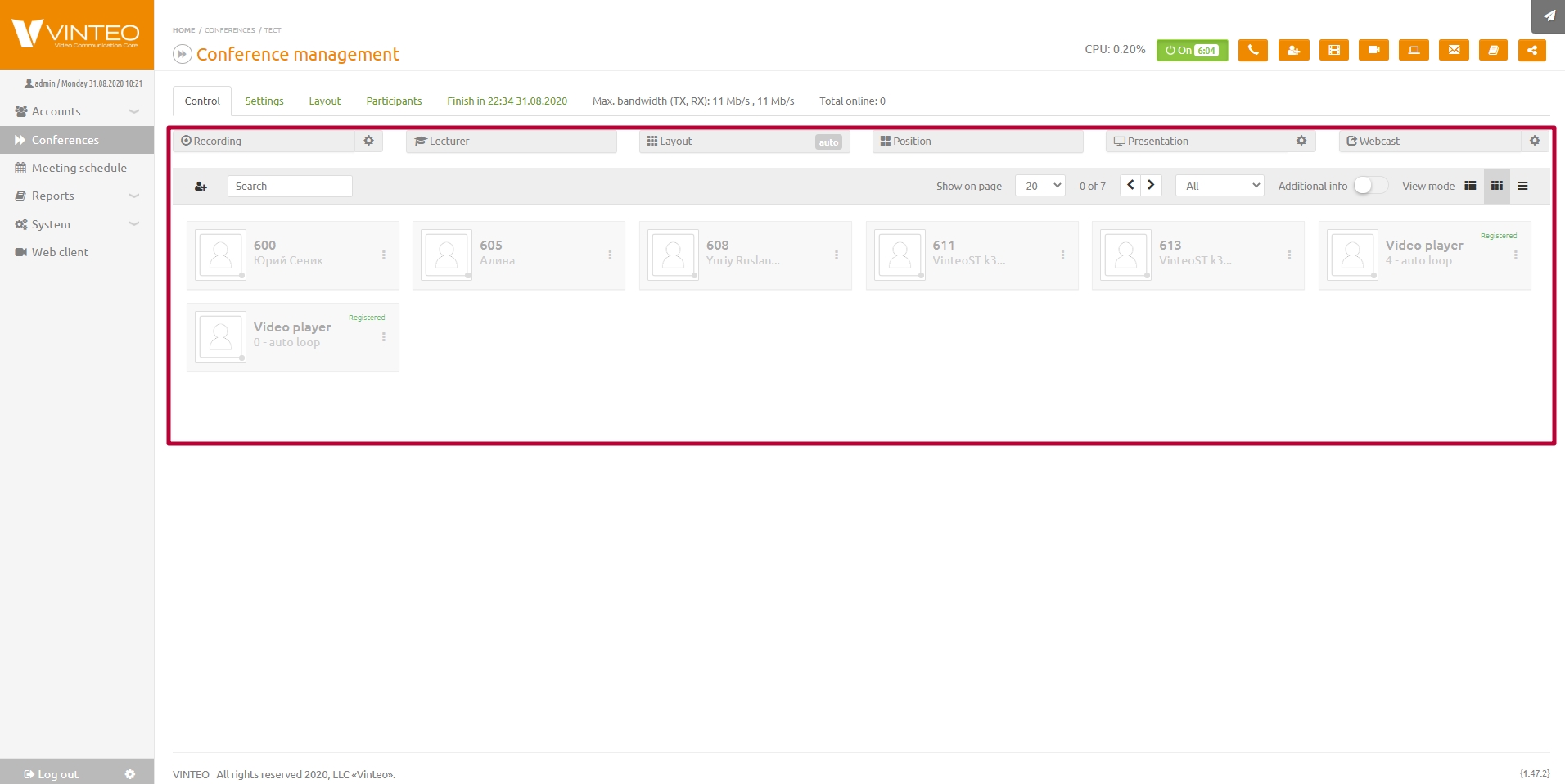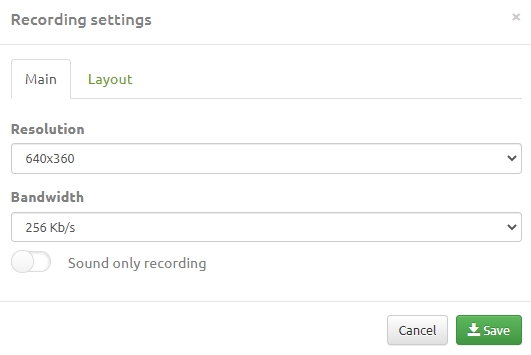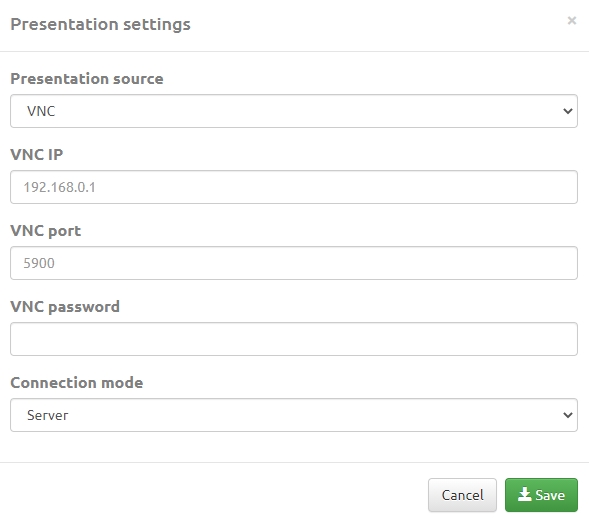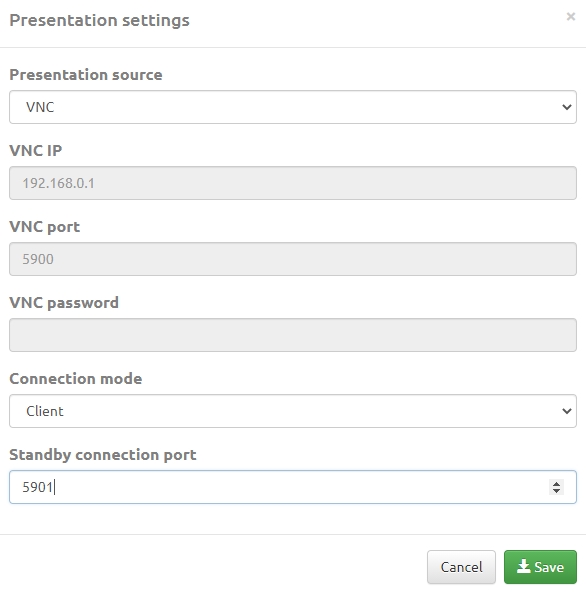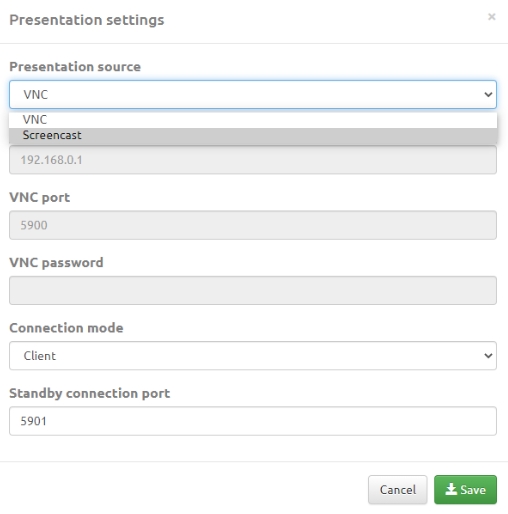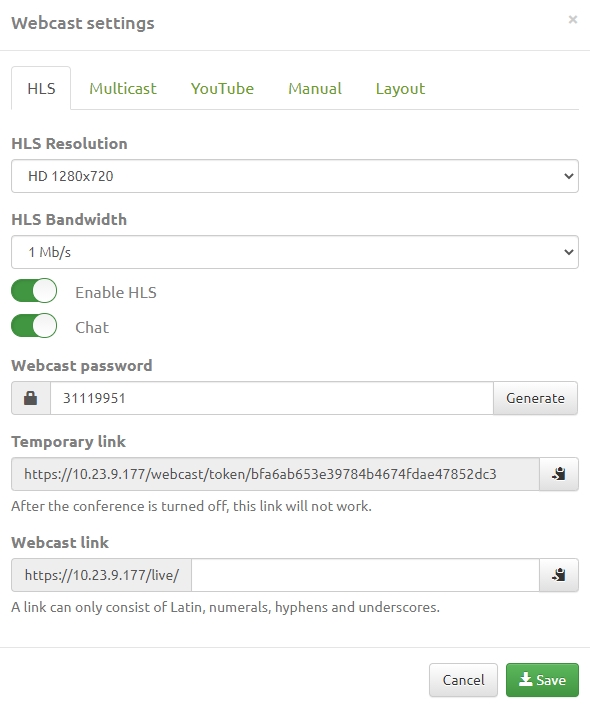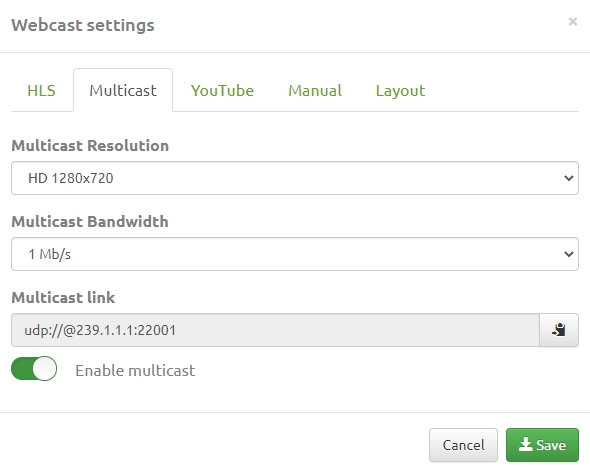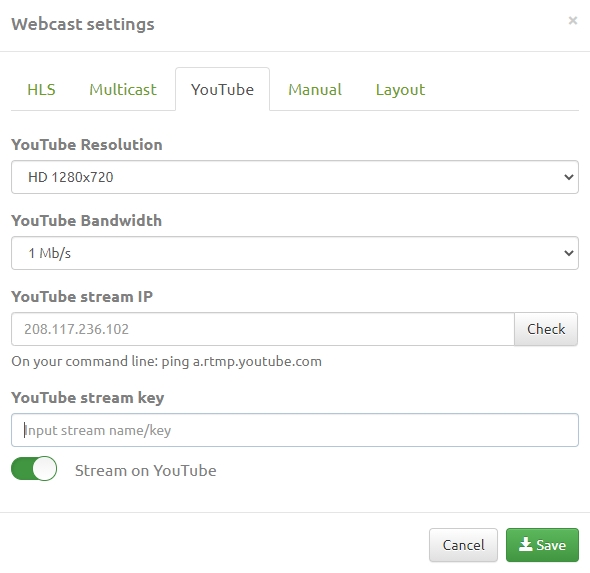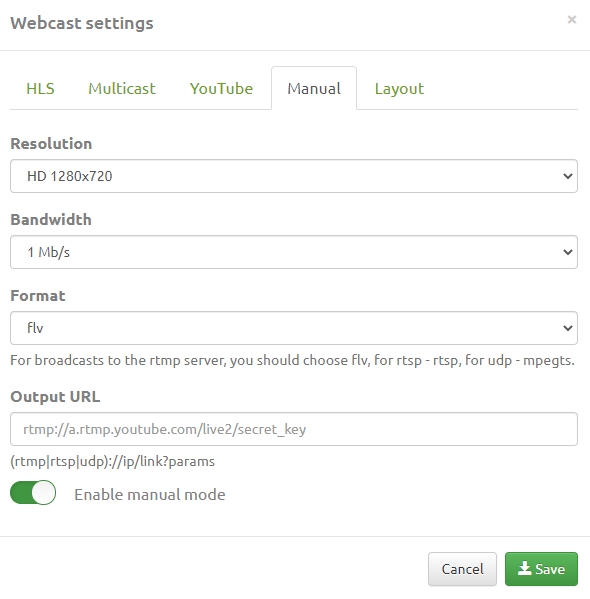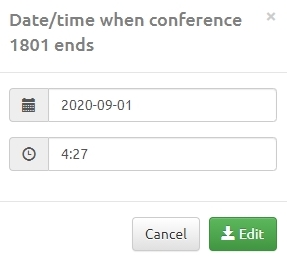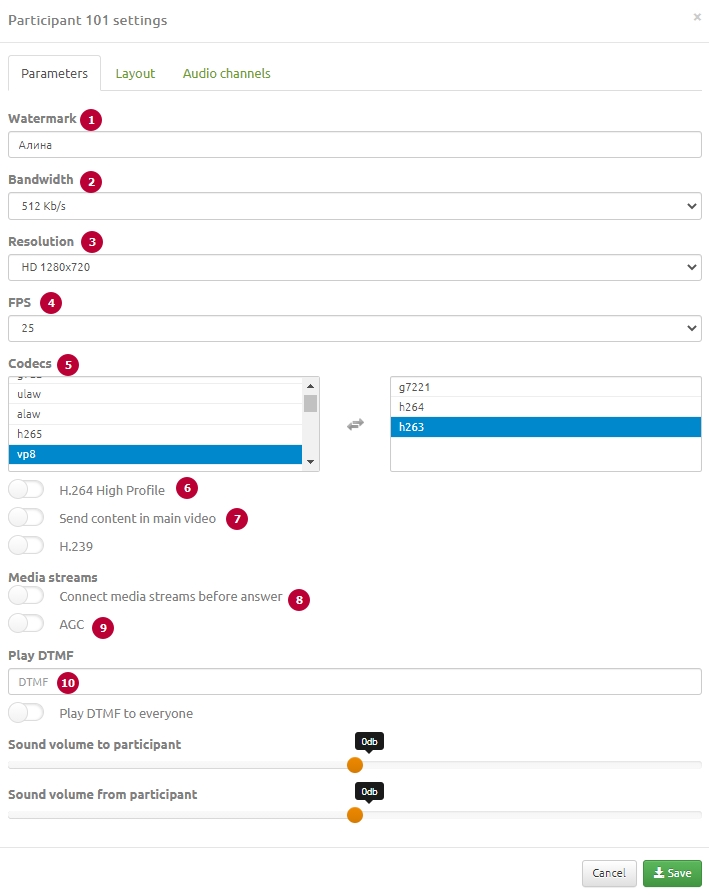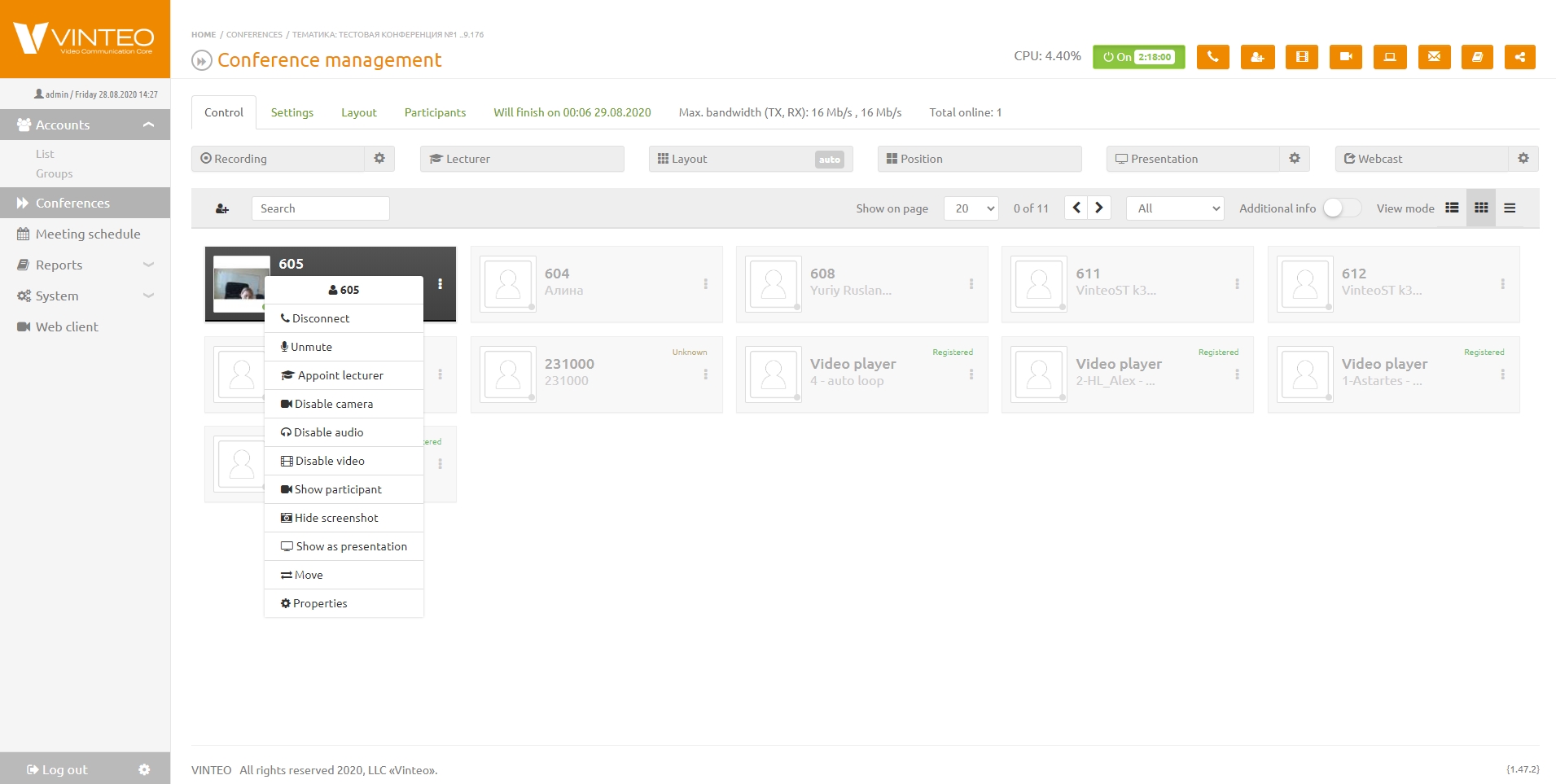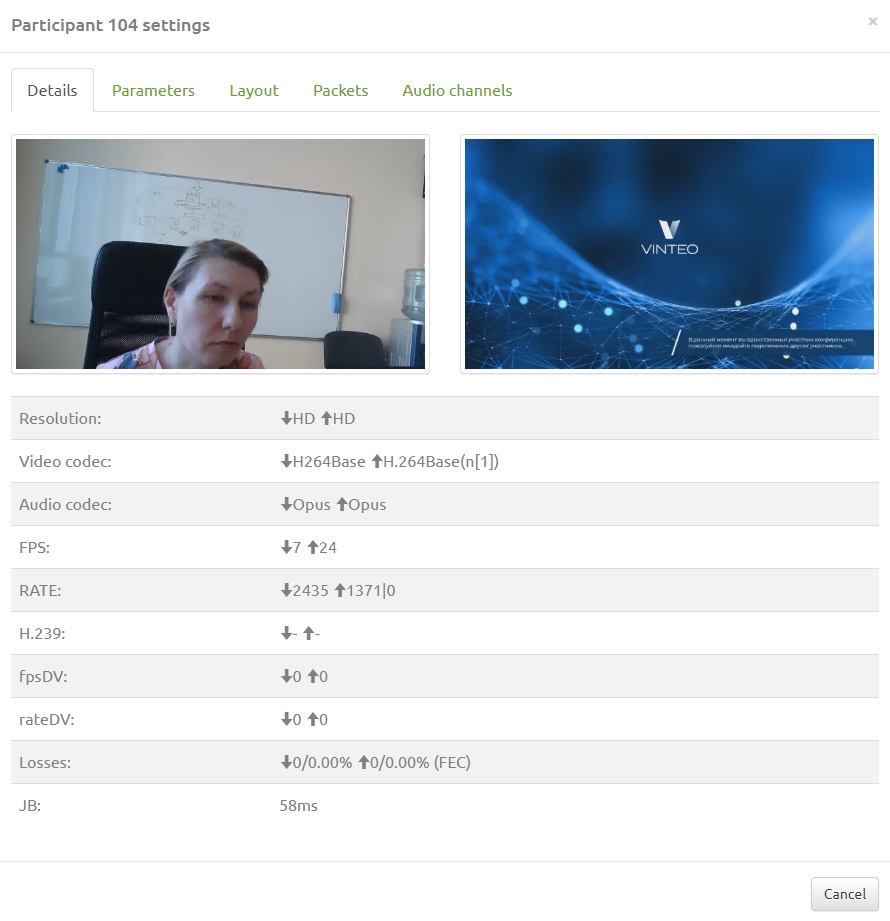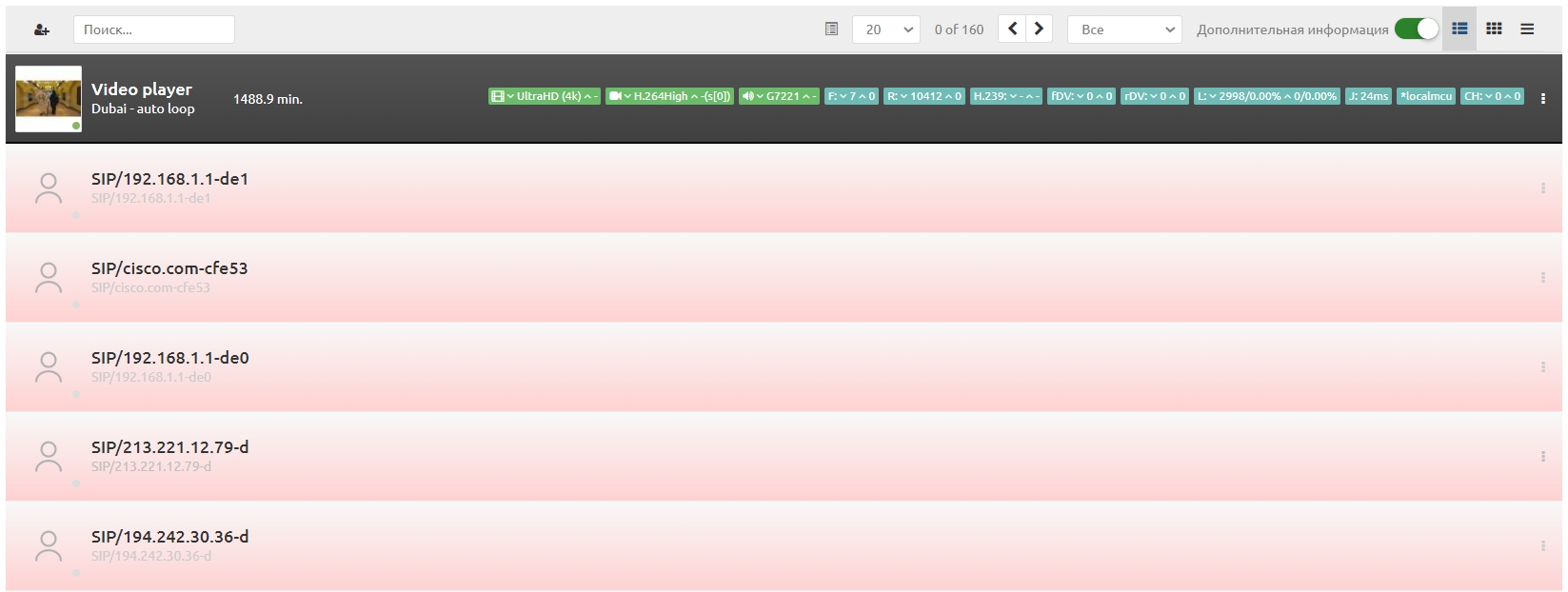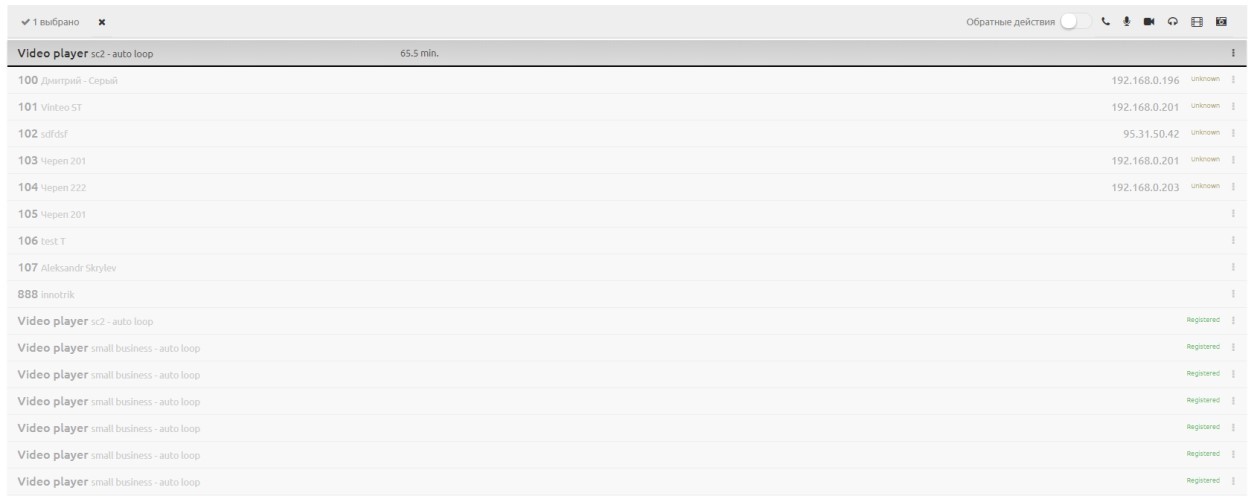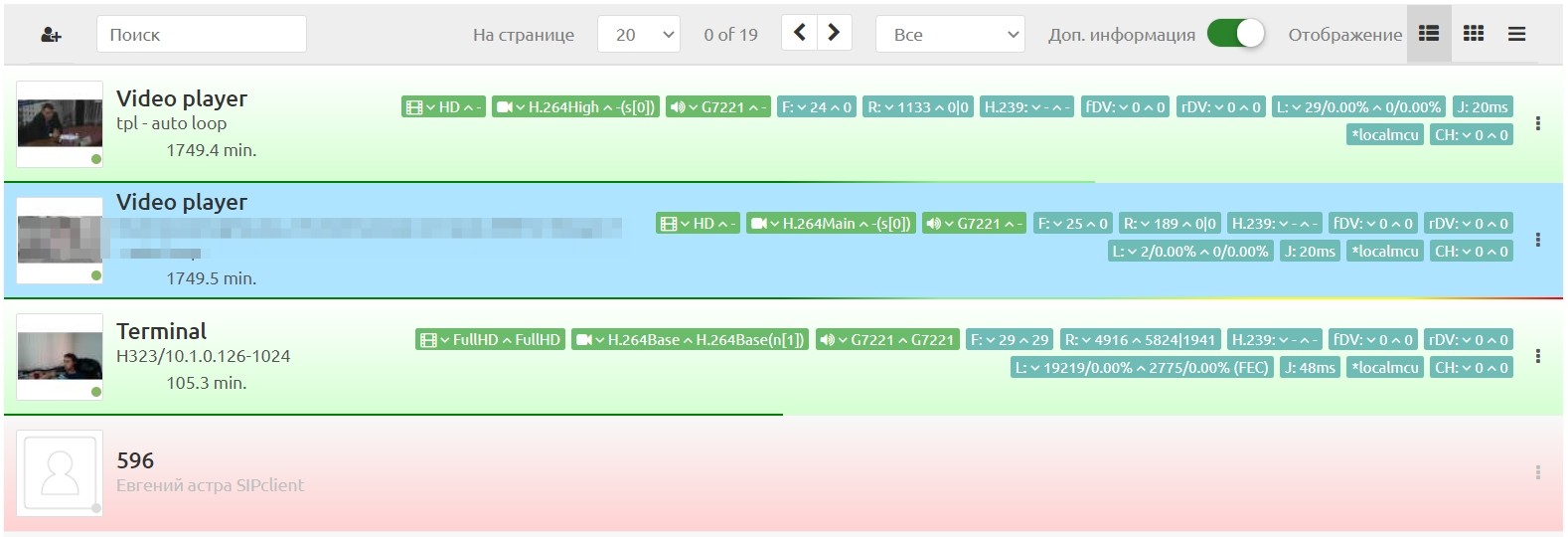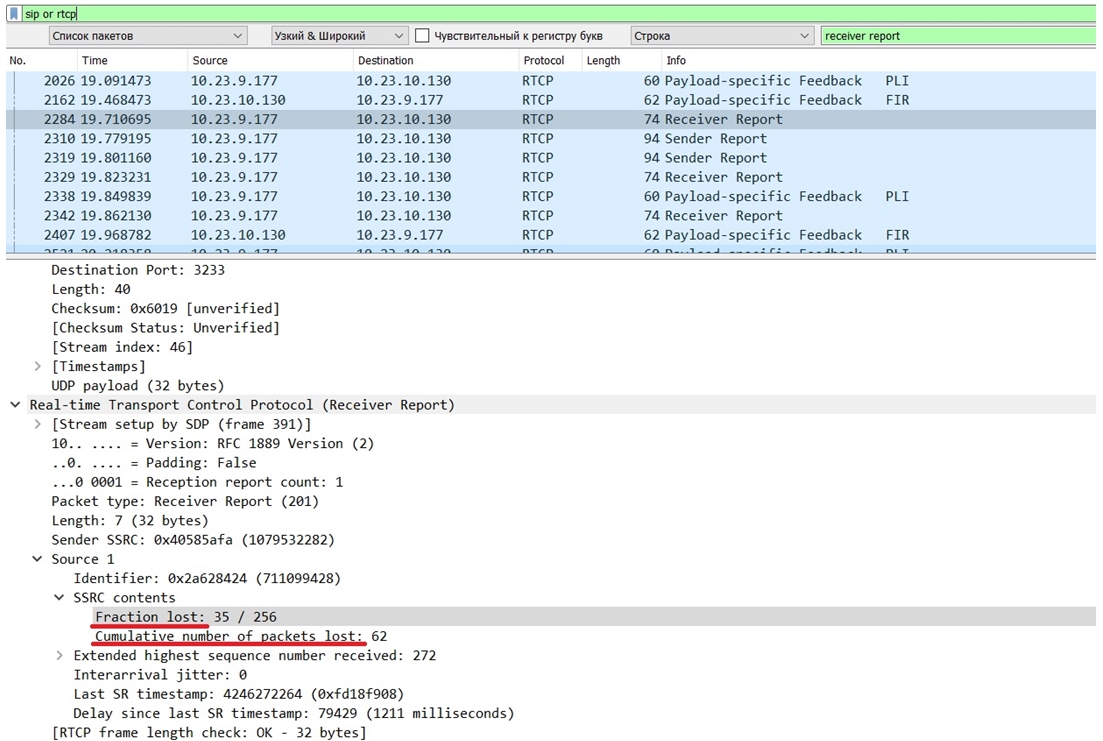Conference management web page
English / General Description / Web interface for configuration and management / Conference management web page
The page is visually divided into three parts:
- Information part
- Navigation part
- Main part
Содержание
The information part
The information part is located in the upper right corner of the page. The information part displays the current conference status, CPU load and conference time. The information part provides access to some functions.
The Dialing
The Dialing function allows you to call a subscriber by IP address or SIP / H.323 URI address, select the resolution of the connected participant, channel width and the number of frames per second. The account you dial will be connected until the end of the call and will not be saved in the list of conference participants. This account can be called multiple times during the conference.
Add participant
The "Add participant" function allows you to create a new participant, select an existing participant, move a participant or add a previously created group of participants. Only those accounts and groups that are visible to the moderator in the address book are available in the list of participants and groups.
To add an account with the "SIP(uri)" type there is one condition: before adding the "name@domain" participant a gateway must be created on the server with the "From domain" line filled in. After adding a participant a “Direction” = name and an account in the address book with the “Loop” type are automatically created in this gateway.
To add an existing account you can use the search line and select the required account. After creating an account you can call him as a participant by clicking the “Add” button.
When you add a participant to a conference you can call them immediately. To do this turn on the “Call participant” switch and then click “Add”.
To move an account from another active conference select the conference from the list; then from the list of the “Participants” tab select the active participant and click the “Add” button. The participant will be called automatically. To add a group of accounts select several accounts from the “Group” list and click the “Add” button. The participants will be called automatically.
Player
The "Player" function allows you to add previously downloaded videos. Choose the file you need from the Videos dropdown list. Switch to the "Auto repeat enable" function if you need and click the "Add" button. If you do not switch on the "Auto repeat enable" function a video will play until the end and it will be set off from the conference.
Video stream
The "Video stream" function allows you to add a video from different sources by HTTP and RTSP protocols. To add a video enter a description in the "Stream description" field, enter the stream address in the "Video stream URL" field and click the "Add" button.
For example, to connect streaming video from a CCTV Beward camera you need to enter an address in the following format: rtsp://XXX.XXX.XXX.XXX:YYY/user&password&channel1&stream
Attention! It is not allowed to use the @ symbol in a password.
- ХХХ.ХХХ.ХХХ.ХХХ is a device network address.
- :YYY is the port of the RTSP stream specified in the device configuration (default: 554).
- user is an administrative user of the device with the right to view the stream.
- password is the password of the administrative user of the device.
- video stream is the digital number of the stream. If your device has more than one stream (0 = main stream).
Message
“Message” is the button in the upper right part of the panel that allows you to send messages to the conference.
Sending a message
Click on the button with the image of an envelope - the modal window will open;
Enter text (the maximum length of one message is 500 characters) in the modal window in the “Message” field.
Click the “Send” button.
Cancelation sending a message
The function allows you to delete a sent displayed message. For do this:
Click the “Clear screen” button. The sent message will disappear from the screen.
Sending a message to one or more selected conference participants
The function that allows you to send a message to the selected participant/s. For do this:
set the “Choose from list” filter. The “Participants” block and the search bar will appear;
Conference log
Conference log function allows you to view all actions and calls of participants and open the modal window with logs of the conference.
Connection link
Connection link function open the modal window with fields which has links to the web client and links for dialing Vinteo Desktop with and without pin code. The moderator may send the link to the participant of the conference in the manual mode. Links with pin code use for the connection to the conference without the proceed of the authorization or entering the pin code manually.
Закладка "Чат"
Закладка "Чат" появится справа в верхней части, если включить переключатель "Чат" в окне настроек "Веб-трансляции".
Нажмите кнопку "Сохранить" для применения настроек.
Чтобы отобразилась статистика чата, нажмите на ссылку "Участников онлайн".
Закладка "Автосекретарь"
Закладка "Автосекретарь" отображается в верхней правой части экрана при попытке звонка на номер выключенной конференции или на несуществующий номер.
В закладке находится ссылка, вызывающая окно перемещения в конференцию из "Автосекретаря".
При нажатии кнопки "Подтвердить" вы можете переместить участника в конференцию либо отключить его от сервера при нажатии кнопки "Отключить".
В окне "Перемещение в конференцию" отображается номер позвонившего участника.
English / General Description / Web interface for configuration and management / Navigation part
Navigation part is located under the Information part. Navigation part allows you to go to Settings, Layout and Participants tabs. The Navigation part displays the maximum channel width, the number of connected conference participants and the duration of the conference, if you specified it.
Main part
English / General Description / Web interface for configuration and management / Main part
Main part is located under the Navigation part and allows you to see the list of participants, the date, conference ending time and make quick settings for such functions as:
- Recording
- Lecturer
- Layout
- Position
- Presentation
- Web cast
Recording
Recording button is divided into two parts. Its left part switches on/off the record of the conference. Its right side allows you to open the modal window with recording settings. Click on the Recording button and the conference will be recorded with the default settings. The next time the conference is turned on, the recording will be done again.
In the main recording settings, you can change:
Resolution
The Resolution string displays the default value set in the settings of the conference itself.
Bandwidth
The string in which you can specify an upper record speed threshold
Sound only recording allows you to choose whether to record audio and video stream or record only audio stream.
Note: Initially, both video and audio are recorded, and only after the end of the recording when saving the selected audio only recording option is applied.
In the Layout tab you can change the way of its order with Use the selected layout of the conference checkbox or with Use the general layout of the conference checkbox you can leave the automatic distribution of participants without affecting the conference layout.
A list of available layouts is found in Appendix 1 1 of this manual.
Lecturer
The Lecturer button controls the switch of the ‘Video-selector’ mode. The identificator of the current participant defined as a lecturer will appear on the button when the ‘Video-selector’ mode is enabled.
Layout
Layout button controls of the view of mosaic and number of participants displayed at the same time.
Position
The Position button opens a modal window with an image of the selected numbered layout and an up-to-date list of participants occupying the corresponding positions. The layout changes online when participants move in the layout.
Presentation
The Presentation button is divided into two parts. The left one enables / disables the video stream with the presentation. The right side of the button gives access to the settings for selecting the presentation source and changing settings. There are two available presentation sources: the default VNC and the Vinteo Scteencast app.
VNC
There are two operating modes available in VNC settings: these are VNC Server and VNC Client. Settings for VNC Server connection mode.
Presentation source is a button with which you can select VNC protocol or video stream from VINTEO Screencast program.
The VNC IP string requires an IPv4 address.
In the VNC port string, you need to specify the port on which the remote server recognizes incoming connections.
In the VNC password string, you need to enter the password from the remote VNC server.
Connection mode is a button that allows you to change the following settings when ‘Client’ is selected.
Standby connection port is a string in which you need to specify the port on which you want to listen for incoming connections.
Screencast
When you select a Screencast presentation source, the server waits for the Screencast application to connect to the conference. If the link with the Screencast is established, the 'monitor' image on the Presentation button will change color to green.
Then when the Presentation button will press the Screencast application will require permission to demonstrate the selected presentation source. If an account has selected the Auto answer on request item in the Vinteo Screencast program in the connection settings and has not canceled the request, then in 5 seconds the application will start showing the presentation.
Webcast settings
In the modal Webcast settings you can change:
- HLS Resolution is a button in the drop-down list of which you can choose the broadcast resolution
- HLS Bandwidth is a button in the drop-down list of which you can choose the broadcast bandwidth.
- Enable HLS is the toggle that enables / disables the use of HTTP based streaming media protocol.
- Chat is a toggle that turns on / off the display of text chat on the broadcast screen.
- Webcast password is the string in which you can specify a random password for protecting a broadcast from unauthorized view.
- Temporary link is a string with a link where the broadcast containing the access key is available. The listener can take part in the correspondence if he entered a name / nickname and if the Chat switch is on.
- Webcast link is the permanent link for the webcast which edit by moderator/administrator. Only Latin, digits, hyphens and underscores can be specified in the Webcast link string.
Multicast tab allows you to change:
- Multicast Resolution is the button with dropdown list in which you can choose the bandwidth broadcast resolution.
- Multicast Bandwidth is the button with dropdown list in which you can choose the broadcast bandwidth.
- Enable multicast is the toggle enable/disable broadcast bandwidth.
YouTube tab allows you to change:
- YouTube Resolution is the button in with dropdown list in which you can choose a resolution in a broadcast bandwidth transmission.
- YouTube Bandwidth is the button in with dropdown list in which you can choose a broadcast bandwidth.
- YouTube stream IP is the string in which you can specify the RTPM address server.
- YouTube stream key is the string for specifying the settings of a video coder key.
- Stream on YouTube is the toggle enable/disable a broadcast on YouTube.
To get the RTMP server address and channel key, follow the link on the YouTube Dashboard and get the key and YouTube broadcast address. On the Position tab, you can change the location of the participants for recording as you want or leave the layout in auto mode.
Manual tab allows you to change:
- Resolution is the button with dropdown list in which you can choose a broadcast resolution.
- Bandwidth is the button with dropdown list in which you can choose a broadcast bandwidth.
- Format is the string with dropdown where you can select flv for rtmp server, for rtsp server you need to select rtsp and for udp server you need to select mpegts.
- Output URL is the string in which you can specify a receiving server address.
Layout tab allows you to change:
- Use the selected layout of the conference is the checkbox which you can choose if you want to use the selected layout.
- Use the general layout of the conference is the checkbox which you can choose if you want to use the general layout of the conference.
The list of available layouts is found in Appendix 1 of this manual.
End time of the conference
The end time of the conference is set at the planning stage of the conference start or during the conference. To change the time of the end of the conference you need to click on the Will finish on [Date], [Time] tab.
Specify a new date and time of ending the current conference in the modal window. Click the Edit button.
Accounts list and DTMF
The accounts list is divided into a list settings menu in which you can add a participant and change the display quantity of participants. You can also set a filtering of participants by their statuses and change list display mode. Changed settings are displayed in real time.
- The choosing of the Call item of the list call the participant of the conference.
- Send invitation to the participant.
- Delete participants to choose this item from the list.
- Participant settings are available with click on his avatar.
All settings in this modal window will be correct for this participant only in this conference except for the settings of codecs and connection modes (items 5,6,7,8).
- Watermark - редактируется текущая подпись участника;
2.Bandwidth button allows you to choose bandwidth for the participant.
3.Resolution button allows you to choose a maximum resolution for the participant.
4.FPS is the button with a dropdown list that allows you to choose a number of frames per second.
5. Codecs is a block with a list of codecs allowed for a participant. If the list is empty, then all codecs from the list on the left are allowed.
6. H.264 High Profile is a switch to enable H.264 codec support for Polycom terminals.
7. ‘Send content in main’ video is a switch for accounts who do not have H.323 installed.
8. 'Connect media streams before answer' is a switch for the server and terminal to transmit information about the codecs used before the subscriber picks up the phone.
9. AGC is the automatic gain control of a sound on the server.
10. Play DTMF string where you can edit before calling the participant to the conference, dialing format ppp1234 #, where p is the delay before dialing DTMF, after going off-hook, equal to 1s.
Layout is the tab where you can edit the participant layout.
When the participant status is active.
- The Disconnect feature allows you to disconnect a participant from an ongoing conference, and the participant becomes inactive.
- Pressing the Mute button disconnects the outgoing audio stream from the participant.
- Pressing Appoint lecturer button assigns this participant as a Lecturer and encloses his video with a yellow border.
- Pressing the Disable camera button turns off the outgoing video stream from the participant.
- Pressing the Disable audio button turns off the incoming audio stream from the participant;
- Pressing the Disable video button turns off the incoming audio stream from the participant;
- Pressing the Show participant button displays the participant's video stream to a position previously reserved for him on the mosaic layout.
- Pressing the Show screenshot button displays a screenshot of the video stream from this participant and places it to the left of the participant's name.
- Pressing the Show as presentation button displays the incoming video stream from the participant on the screen as a presentation
- Move button allows you to move the participant of this conference to any other active conference by selecting it from the drop-down list in the modal window.
- Pressing the Properties button brings up a window with technical information about the participant such as his camera resolution, video codec, audio codec, FPS, RATE, H.239, fpsDV, rateDV, loss, JB and allows you to change the sound volume to and from the participant in the Parameters tab.
The list displays the participants statuses:
- as tiles when you hover the cursor over the connected participant.
The statuses are displayed permanently as strings. In this view, you can display additional connection parameters, such as losses, the number of transmitted frames in video streams, the current bitrate of video streams, and so on when you enable the Additional information item.
It is available to display the IP address of the participant and the status of registration on the server in the short list.
Standard statuses display the following participant connection information:
- The participant connection status is the string of the participant connection which is colored by a gradient of light green.
- The frame of a participant in the Lecturer status is colored light blue.
- The time of participant connection.
- The frame of a participant in the Lecturer status is colored light blue.
- The arrow in front of the video resolution of the connection to the conference participant's server indicates the direction of the flow. If there is a dash instead of a value, then there is no video stream. Information in other statuses is displayed in the same way.
- Video codecs used by the conference participant
- Audio codecs used by the conference participant.
Extended statuses display the following conference participant connection information.
- The number of frames per second in the participant's video stream.
- The current value of the bandwidth occupied by the main video data stream.
- The receiving/sending status of the content stream on H.239, BFCP protocols.
- The number of frames per second in the content video stream on H.239, BFCP protocols.
- The current value of the bandwidth occupied by the additional video stream for transmitting content on H.239 and BFCP protocols.
- The number of lost packets and the total percent of losses at the present time in the transmission of the participant's video streams.
- The server's adaptive jitter buffer value for a particular participant is measured in milliseconds and reflects the state of the data transfer channel from the participant to the server. The higher this indicator, the greater the video delay for this participant.
- Participant connection server. In case cascading is used.
Управление группой участников
Есть возможность управлять настройками группы участников. Если выбрать одного или нескольких участников из списка, появится панель группового управления с кнопками:
- "Включить" - нажатие этой кнопки добавляет выделенных участников (одного или нескольких) в конференцию;
- "Включить микрофон" - кнопка включения микрофона у одного или нескольких участников;
- "Включить камеру" - кнопка включения камеры у одного или нескольких участников;
- "Включить звук" - кнопка включения звука у одного или нескольких участников;
- "Включить видео" - кнопка включения видео у одного или нескольких участников;
- "Показать/Скрыть скриншот" - кнопка вывода скриншота у одного или нескольких участников.
Если активировать переключатель "Обратные действия", то все перечисленные кнопки приобретут обратный функционал, при этом действие будет производиться с выбранными участниками.
В данном списке отображение статусов участников производится следующим образом:
- в виде плиток, при наведении курсора на подключенного участника;
Изображение закрытого замка показывает, что происходит шифрование RTP-трафика.
- в виде строк статусы отображаются постоянно, в этом виде доступен вывод дополнительных параметров подключения, таких как потери, количество передаваемых кадров в видеопотоках, актуальные битрейт видеопотоков и т.д. при включении пункта "Доп. информация";
- в виде краткого списка – доступно отображение IP-адреса участника и статус регистрации на сервере.
Статусы подключения участника
Стандартные статусы выводят следующую информацию подключения участника:
- светло-зеленый цвет - участник подключён;
- строка, окрашенная в тёмно-зеленый - это участник, который показывает презентацию;
- текущий лектор – строка выделяется светло-голубым цветом среди подключенных участников;
- жёлтый цвет - означает, что участник смотрит веб-трансляцию, а также запрос слова;
- серая строка - это добавленный в конференцию участник, но не подключенный;
- чёрный цвет означает, что у участника выключен микрофон;
- Время подключения участника;
- Видеоразрешение подключения к серверу участника конференций - стрелка перед значением указывает направление потока, если вместо значения появляется прочерк, то видеопотока нет. Аналогичным образом строятся остальные статусы;
- Используемые видеокодеки подключения участника конференций;
- Используемые аудиокодеки подключения участника конференции;
Расширенные статусы выводят следующую информацию подключения участника:
- Количество кадров в секунду в видеопотоках участника;
- Текущее значение полосы пропускания, занимаемое основным потоком видеоданных;
- Forward error correction - восстановление потерянных пакетов;
- Overhead - дополнительный трафик, который содержит дубликаты пакетов, с помощью которых произойдет восстановление, если какие-либо пакеты будут потеряны.
- Статус приема/отправки потока контента по протоколам H.239, BFCP;
- Количество кадров в секунду в видеопотоке контента по протоколам H.239, BFCP;
- Текущее значение полосы пропускания, занимаемое дополнительным видеопотоком для передачи контента по протоколам H.239 и BFCP;
- Количество потерянных пакетов и общий процент потерь в настоящий момент времени в передаче видеопотоков участника;
- Значение адаптивного джитер-буфера сервера для конкретного участника измеряется в миллисекундах и отражает состояние канала передачи данных от участника к серверу, чем выше этот показатель, тем больше задержка видеоизображения у данного участника;
- Сервер подключения участника, в случае если используется каскадирование.
- Информация о входящем и исходящем аудиоканалах.
Индикация потерь
На индикаторе потерь отображаются входящие и исходящие потери. Для каждого направления показано общее количество потерянных пакетов и мгновенные потери пакетов в процентах.
Определить наличие и величину потерь сетевых пакетов отдельных подключений к сеансу ВКС можно в "Управлении конференцией". Для этого нужно выбрать расширенное отображение участников в конференции и включить переключатель "Доп. информация".
Информацией о потерях стороны подключения (сервер и клиент) обмениваются по протоколу RTCP (https://datatracker.ietf.org/doc/html/rfc3550#section-6 ) отправляя раз в 2-3 секунды друг другу Receiver Report (RR) (https://datatracker.ietf.org/doc/html/rfc3550#section-12.1), который содержит следующие параметры:
Cumulative number of packets lost - общее количество потерянных пакетов, считается с момента подключения участника к серверу.
Fraction lost - доля потерянных пакетов, рассчитанная за время с момента предыдущего отправленного отчета RR.
Скриншот из программы Wireshark c дампом сетевого трафика SIP-подключения и наложенным фильтром для отображения только пакетов протокола RTCP:
Именно эти значения и выводятся на индикаторе потерь по каждому подключению:
На индикаторе отображаются отдельно входящие (1) и исходящие (2) потери.
Пересчет информации производится при получении или отправке каждого RR: входящие потери (in) считает сервер, а исходящие потери (out) считает клиент.
